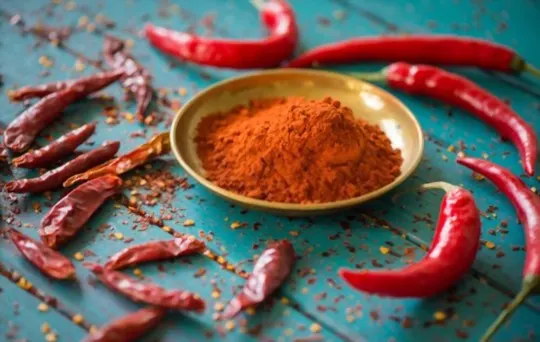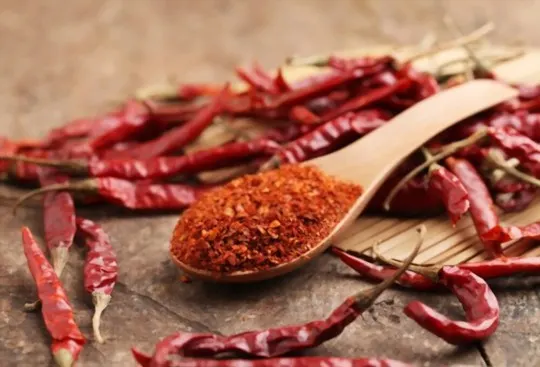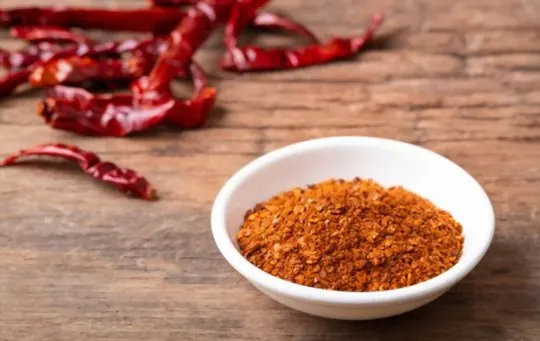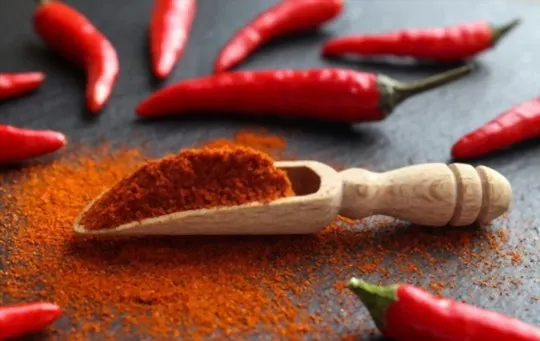We know them.
We love them.
But what’s really the difference between chili powder and cayenne pepper? If you struggle with this perplexing question, never fear.
In this blog post, we’ll break down all of the differences between these two spices to help educate you on how they work together in your favorite dishes—or if they can even be used interchangeably at all.
With plenty of details extensively examined, by the time you finish reading this post, there won’t be a single spice left out when it comes to making your culinary masterpieces just right.
Read on for an educational yet confident look into understanding how one simple ingredient could truly transform flavor profiles in any dish.

What is Chili Powder?

Chili powder is a staple ingredient in many kitchens across the globe.
It is a flavorful blend of spice that brings a powerful kick to any dish.
At its core, chili powder is made up of dried chili peppers that have been ground into a fine powder.
While the recipe for chili powder may vary from region to region, most blends include a combination of chili peppers, cumin, garlic, and oregano.
The heat level of chili powder can vary depending on the type of chili peppers used, with some blends having a mild flavor and others packing a punch.
With its bold flavor and versatility, chili powder has become a beloved ingredient in countless recipes, from chili con carne to seasoned roasted vegetables.
So, now that we know what chili powder is, let’s explore the types of chili peppers that are commonly used to make this fiery spice.
What is Cayenne Pepper?

When it comes to spices, cayenne pepper is one that often gets overlooked in the pantry.
However, this fiery red spice packs a punch in both taste and health benefits.
Cayenne pepper is made from dried and ground chili peppers, specifically the Capsicum annuum species.
It is named after the city of Cayenne in French Guiana, where the pepper was commercially traded.
With its primary compound, capsaicin, cayenne pepper is known for providing a warming and slightly bitter taste.
Besides being used as a seasoning for food, cayenne pepper has also been utilized for its medicinal properties, including pain relief and digestive health.
In this article, we will dive into the in-depth details of this often-overlooked spice, from its history to its uses, and the potential risks involved with consuming too much.
By the end, you’ll be a cayenne pepper expert and appreciate the spice for all it has to offer.
Differences Between Chili Powder and Cayenne Pepper

These two spices may appear to be similar, but they are different in many ways.
Chili powder is a blend of ground chili peppers and other seasonings like garlic, cumin, and oregano.
On the other hand, cayenne pepper is simply ground dried red chili pepper.
The main difference lies in their heat intensity, with cayenne being significantly hotter than chili powder.
As such, one should take care when substituting one for the other in recipes.
Ingredients Used
The spices used in cooking can make a significant difference in the taste and flavor of any dish.
One such ingredient that adds a zing to recipes is chili powder or cayenne pepper.
Both these spices are added to dishes around the world for their unique tastes and health benefits.
When it comes to distinguishing between chili powder and cayenne pepper, there are some differences in their properties.
Chili powder is a combination of different types of ground dried chilies, along with added spices like coriander, oregano, garlic powder, and cumin.
Cayenne pepper, on the other hand, is made from only one type of chili – the red-hot chili pepper.
Furthermore, when it comes to spiciness level, cayenne pepper is much hotter than chili powder.
Cayenne has a rating of 30,000 to 50,000 Scoville units (the scale used for measuring a chili’s heat), whereas most standard chili powders come in at around 1,000 to 2,000 Scoville units.
In summary, both chili powder and cayenne pepper can add an extra kick to your meals; however, it depends on individual preferences and recipe requirements.
While cayenne pepper brings out the heat more intensely than chili powder does but if you want to take advantage of subtle flavors created by other added ingredients in dishes then opt for chili powder since it contains different varieties of ground dried chilies with potential health benefits like anti-inflammatory properties against different diseases like cancer due to its capsaicin compound.
Flavor and Heat Intensity
The essence of both Chili Powder and Cayenne Pepper lies in their flavor and heat intensity.
While both spices originate from the Capsicum family, there are subtle differences between them.
The flavor profile of Chili Powder has a richness that comes from the blend of other spices like garlic, cumin, and oregano added to it.
On the other hand, Cayenne Pepper is pure heat with no distinct taste beyond its pungency.
When it comes to heat intensity, Cayenne Pepper is hotter than most chili powders as it has a Scoville rating which measures between 30,000 to 50,000 units while Chili Powder rates below 1000 units.
It’s worth noting that different brands of Chili powder have varying levels of heat depending on the type of chili included in the blend.
For cooks seeking a milder flavor with added complexity for an array of dishes ranging from stews to rubs for grilling meat or fish, Chili Powder offers terrific benefits.
Meanwhile, those who find pleasure in intense heat will enjoy incorporating Cayenne pepper into their recipes.
In summary, choosing either spice depends on personal preference and intended use in cooking or specific recipes calling for one variety over another.
Nutritional Value
The ingredients present in chili powder and cayenne pepper provide distinct nutritional benefits.
Both spices are rich in antioxidants, vitamins, and minerals that help boost the immune system, promote healthy digestion and reduce inflammation.
Chili powder is a blend of several spices that include chili peppers, cumin, garlic powder, oregano, salt and sometimes even sugar.
Whereas cayenne pepper is a bright red spice made from dried and ground chili peppers that contain capsaicin which can aid in reducing pain perception.
In terms of nutritional value, both chili powder and cayenne pepper offer unique benefits to the body.
While chili powder contains significant amounts of iron and vitamin A due to its inclusion of spices like cumin and oregano; cayenne pepper surpasses it concerning dietary fiber density with significant amounts of potassium and flavonoids which aid in elevating good cholesterol levels.
Moreover, research has suggested that cayenne pepper may also have thermogenic properties which might help regulate weight loss by increasing metabolic activity by burning calories effectively.
It’s crucial to choose the right spice according to your preference while keeping in mind their individual nutritional values.
Consult a dietitian before making any changes to your daily diet plan as it could have adverse health effects for individuals who exhibit sensitivity or allergies towards these spices when consumed in large amounts.
Culinary Uses
The use of spices is an essential part of cooking, and different cuisines have their unique blends and preferences.
Spices add flavor, color, aroma, and texture to the dishes.
When it comes to hotness, chili powder and cayenne pepper are popular choices.
Chili powder is a blend of ground chili peppers along with other herbs such as cumin, garlic powder, oregano, etc.
It has a mild to medium heat level and is commonly used in Mexican cuisine for making dishes like tacos, enchiladas, etc.
On the other hand, cayenne pepper is made from dried and grounded red chili peppers.
It is hotter than chili powder and adds intense heat to the recipes.
Cayenne pepper is often used in spicy dishes from Asian & Caribbean regions.
Apart from their heat levels, both spices have distinct flavors that can affect the taste of the dish.
For example – if you want to make a mild flavored dish with added spice, then chili powder should be your choice as it will provide the necessary heat without altering the taste much.
But if you love intense flavors with a high level of spiciness, then cayenne pepper can be used in small quantities.
Health Benefits of Chili Powder and Cayenne Pepper

Chili Powder and Cayenne Pepper are known for their health benefits and adding a spicy flavor to the dishes.
The question arises, which of these two is a better option to add to your diet?
There are several health benefits of consuming Chili Powder and Cayenne Pepper.
Here are five benefits:
- Both Chili Powder and Cayenne Pepper have anti-inflammatory properties that help in reducing inflammation in the body.
- Due to the presence of capsaicin, Chili Powder and Cayenne Pepper increase metabolism, burn calories faster, and aid in weight loss programs.
- Chili Powder and Cayenne Pepper contain antioxidants that help in fighting free radicals, boosting immunity, improving digestion, and reducing oxidative stress.
- The bioactive compounds present in Chili Powder and Cayenne Pepper can help regulate blood sugar levels, prevent diabetes, heart diseases, and enhance heart health by controlling cholesterol levels.
- Consuming Chili Powder or Cayenne Pepper can also provide relief from pain both externally (applied topically) or internally (consumed orally).
It is important to note that excessive consumption of these spices may cause irritation or damage to the digestive tract.
Anti-Inflammatory Properties
Spices and herbs are a great way to enhance the flavor of food.
Not only this, but chili powder and cayenne pepper have been known for their anti-inflammatory properties.
So which one is better? Although both are beneficial, cayenne pepper has higher levels of capsaicin which may help reduce inflammation more effectively than chili powder.
Cayenne pepper not only provides relief from pain and inflammation, but it also contains important antioxidants that help prevent damage caused by free radicals.
Plus, it has been shown to improve digestion and prevent blood clots.
However, chili powder should not be overlooked as it also contains antioxidants and has anti-inflammatory benefits.
It also adds a unique taste to dishes and can be a good option for those who prefer a milder taste compared to cayenne pepper’s heat.
Metabolism Boosting
Boost Your Metabolism Naturally with Food Spices.
Certain food spices are known to have metabolism-boosting properties.
Here are some ways in which these natural ingredients work their magic:
- They help increase your body’s metabolic rate, leading to more calories burned.
- They contain antioxidants that help protect the cells and promote overall health.
- They can suppress your appetite, helping you consume fewer calories throughout the day.
- Some spices may even improve your digestion, leading to better nutrient absorption and more energy for your body.
In addition to their ability to aid in digestion and metabolic functions, certain natural spices have unique properties that can benefit overall wellness.
These benefits range from anti-inflammatory and anti-bacterial effects to a boost in cognitive function.
So next time you’re looking for a way to naturally enhance your metabolism or improve overall well-being, consider incorporating food spices into your diet.
From chili powder and cayenne pepper to turmeric and ginger, the possibilities are endless.
Digestive Health
Digestive health is essential for the proper functioning of our body.
The human digestive system is complex and requires regular maintenance to keep it running smoothly.
A healthy diet can benefit digestive health, leading to improved digestion, absorption and elimination processes.
Nutritious foods are paramount in supporting healthy gut bacteria that helps to break down food and absorb nutrients efficiently.
Spices are known for their medicinal properties, including aiding in digestion.
Chili powder and cayenne pepper are two popular spices with distinct flavors and unique benefits for digestion.
Both spices contain capsaicin which stimulates saliva production, neutralizing stomach acid levels aiding in digestion.
Cayenne pepper contains capsaicin which aids in reducing inflammation and improving blood flow throughout the gastrointestinal tract promoting good digestive health.
It has a thermogenic effect that raises the body temperature thereby increasing metabolism resulting in better bowel movement.
Chili powder contains a blend of various ground peppers that may contain other seasonings such as garlic, onion or turmeric.
This mix can have alkalizing effects on stomach acid while providing anti-inflammatory properties including calming an upset stomach.
Thus, both spices have unique properties proven to aid digestive health when used correctly.
Incorporating them into your meals regularly may be beneficial when paired with a balanced diet devoid of spicy or acidic food that may aggravate conditions such as acid reflux or ulcers.
Recipes and Dishes Featuring Chili Powder and Cayenne Pepper

Chili powder and cayenne pepper are essential ingredients in several dishes, adding an extra kick of heat.
These spices work wonders when used together or individually in various cuisines.
Discover versatile recipes featuring these flavorful spices with unique taste profiles that can enliven any meal.
Explore savory options like vegetarian chili, roasted chicken breasts, and taco seasoning blends that infuse the perfect balance of heat and flavor into your food.
The combination of chili powder and cayenne pepper is ideal for curries, soups, sauces, and dips; with its pungent aroma and delectable taste profile, it elevates the flavors of dishes like no other.
If you have a penchant for spicy food, try adventurous recipes such as hot sauce or spicy salad dressing that utilize these potent spices in tantalizing ways.
Add a pinch of paprika or smoked salt to these recipes to take them to the next level.
To sum up, both chili powder and cayenne pepper offer unique advantages in cooking.
Whether you prefer a milder or spicier alternative is entirely dependent on individual taste preferences.
Regardless of choice, these spices give amazing depth to your meals’ flavors while remaining versatile enough to use in nearly any recipe requiring a warm kickback.
Conclusion
After reading this blog post, it should be clear that while chili powder and cayenne pepper are similar, they are far from the same.
From their colors to their levels of heat, these two spices offer completely different experiences for consumers.
While chili powder makes for a great addition to any Mexican dish to give it an earthy flavor, cayenne can provide a much more intense spicy kick.
Though these two are often considered interchangeable, people should take into account the differences between each one before deciding what spice suits them best and taking on their own culinary adventures.
Whether trying something new or utilizing a beloved classic, consider using either chili powder or cayenne pepper within your own creations knowing all of the information above about the two spices.
Who knows – maybe you’ll create something wonderful.

Chili Powder vs Cayenne Pepper: Which is a Better Option?
Ingredients
- Chili Powder
- Cayenne Pepper
Instructions
- Choose between two items based on your preference and availability.
- Follow the cooking directions for your chosen option, using the appropriate ratio of ingredients.
- Prepare it according to your desired consistency and spiciness.
- Incorporate the paste into your dish, adjusting the amount to suit your taste.
- Enjoy the unique taste experience and experiment with different dishes to explore their versatility.

Andrew Gray is a seasoned food writer and blogger with a wealth of experience in the restaurant and catering industries. With a passion for all things delicious, Andrew has honed his culinary expertise through his work as a personal chef and caterer.
His love for food led him to venture into food writing, where he has contributed to various online publications, sharing his knowledge and insights on the culinary world. As the proud owner of AmericasRestaurant.com, Andrew covers a wide range of topics, including recipes, restaurant reviews, product recommendations, and culinary tips.
Through his website, he aims to inspire and educate fellow food enthusiasts, offering a comprehensive resource for all things food-related.
